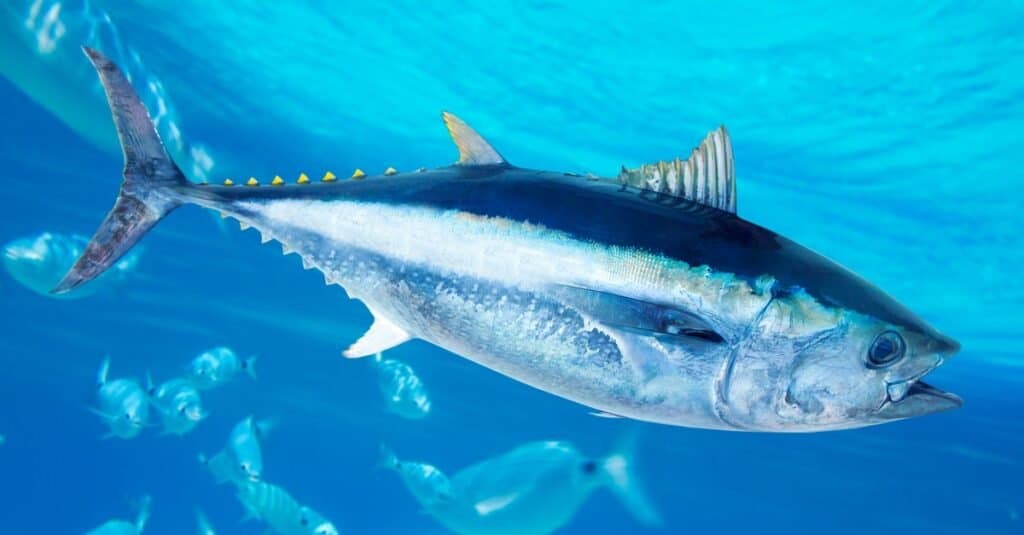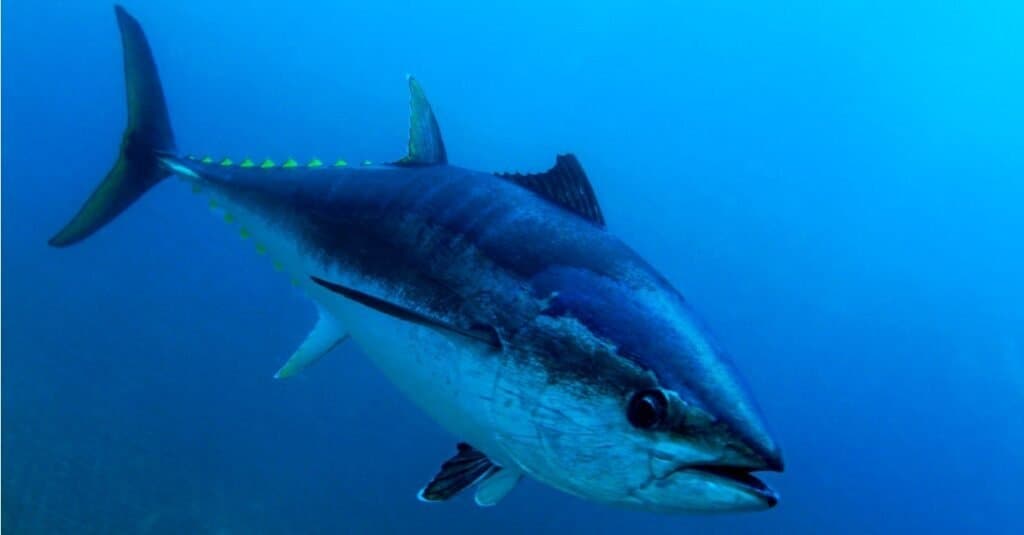Tuna are some of the best known fishes in the world due to the popularity of their meat. However, the fish themselves are huge, powerful predators which also make them hugely popular as game fish too. There are 15 species of tuna which are found in virtually all major oceans. Of these, bluefin tuna are easily some of the most popular – and the largest. However, they can sometimes be confused with big eye tuna which have an incredibly similar appearance at first glance. Luckily, there are a few key differences that we can use to tell them apart. So join us as we discover everything you need to know about big eye tuna vs bluefin tuna!
Comparing Bluefin Tuna vs Big Eye Tuna

Bluefin tuna and bigeye tuna are both highly migratory and have a similar appearance. However, when we talk about bluefin tuna we’re actually not talking about just one species. This is because there are three species of tuna which are known as bluefin tuna – Atlantic bluefin tuna (Thunnus thynnus), Pacific bluefin tuna (Thunnus orientalis), and Southern bluefin tuna (Thunnus maccoyii). Of these the Atlantic bluefin in classed as an endangered species, while Southern bluefins are critically endangered. Additionally, bigeye tuna (Thunnus obesus) are classed as a vulnerable species.
| Bluefin Tuna | Bigeye Tuna | |
| Location | Pacific bluefin – northern Pacific, migrates to southern Atlantic bluefin – western and eastern Atlantic, Mediterranean Sea Southern bluefin – southern hemisphere waters of all oceans | All tropical and temperate oceans, except the Mediterranean Sea |
| Depth | Up to 3,300 feet | Up to 1,640 feet |
| Size | Length – up to 12 feet Weight – up to 1,500 pounds | Length – up to 8 feet Weight – up to approx 400 pounds |
| Appearance | Heavy body, dark blue back, silver or white lower sides and belly. White lines and spots on underside. Second dorsal fin dark colored. Blue tail fin | Blue back and upper sides, white belly and lower sides. Pale yellow anal fins and second dorsal. Finlets yellow with black edges. Yellow and grey tail fin |
| Pectoral Fins | Short – ends before the second dorsal fin | Long – extend towards second dorsal fin on adults, beyond on juveniles |
| Diet | Fish (mackerel, herring, sardines, anchovies, smaller tuna), jellyfish, octopus, crabs, squid, crustaceans, eels | Fish, crustaceans, squid |
| Predators | Orcas, pilot whales, sharks | Sharks, whales, larger tuna |
| Lifespan | 40 years | 15 years |
The 5 Key Differences Between Bigeye Tuna and Bluefin Tuna
Bigeye Tuna vs Bluefin Tuna: Size

Bluefin tuna can reach 12 feet long and weigh an immense 1,500 pounds!
©lunamarina/Shutterstock.com
One of the most noticeable differences between bluefin and bigeye tuna is their size. Bigeye tuna can reach up to 8 feet long and weigh up to approximately 400 pounds and on the whole they are a lot smaller than bluefin tuna. Although all three bluefin tuna species are on average larger than bigeye tuna, when we break down the size between the different species we find that it is the Atlantic bluefins which are by far the biggest. Pacific bluefins can be up to 9.8 feet and weigh up to 990 pounds, while Southern bluefins are up to 8ft 2ins and weigh up to 570 pounds. However, Atlantic bluefin tuna can reach 12 feet long and weigh up to an incredible 1,500 pounds!
Bigeye Tuna vs Bluefin Tuna: Location
Bluefin tuna are widely distributed around the world, with their location depending on the species. Pacific bluefin tuna are native to the northern Pacific Ocean but migrated to the southern Pacific. Atlantic bluefin tuna are native to the western and eastern Atlantic Ocean as well as the Mediterranean Sea, while Southern bluefin tuna are native to the southern hemisphere waters of all major oceans.
Although bigeye tuna are also widely distributed across all tropical and temperate oceans, they are not found in the Mediterranean Sea – meaning if you come across any tuna there then it is not a bigeye tuna.
Bigeye Tuna vs Bluefin Tuna: Appearance
The most distinctive difference between bigeye and bluefin tuna is their appearance. Bigeye tuna have dark blue backs and upper sides while their bellies and lower sides are silver to white. Their second dorsal fin and anal fins are pale yellow and their finlets are yellow with black edges. Their tail fin is a mixture of yellow and grey colors.
Blue fin tuna have heavy, thick-set bodies which are incredibly powerful and built for speed. Although they have similar colors to big eye tuna – dark blue backs and grey or white lower sides and bellies – they have different fin colors. The second dorsal fin on bluefin tuna is dark colored compared to the yellow of big eye tuna and their tail fin is dark blue. Bluefin tuna also have many whitish-colored lines and spots on the underside of their bodies.
Bigeye Tuna vs Bluefin Tuna: Pectoral Fins
Bigeye tuna are also distinguished by their long pectoral fins. The pectoral fins of adults reaches the area between the two dorsal fins, while on juveniles they go beyond the beginning of their second dorsal fin. However, the pectoral fins are much shorter on bluefin tuna and end well before the second dorsal fin.
Bigeye Tuna vs Bluefin Tuna: Water Depth

Bluefin tuna can dive as deep as 3,300 feet while searching for food!
©iStock.com/Whitepointer
Another difference between bluefin and bigeye tuna is how deep they can dive. Bigeye tuna dive to depths of around 1,640 feet. They regularly undertake diurnal vertical migration whereby they travel down into the deeper, cooler waters during the day and then return to the shallower, warmer waters at dusk. The deeper water can be up to 20° cooler than the water at the surface of the ocean.
Most bluefin tuna dive much, much deeper than big eye tuna, with Atlantic bluefins diving the deepest. Pacific bluefin tuna can dive up to 1,800 feet, although they usually only occur between the surface and 660 feet. Southern bluefin tuna dive up to 1,640 feet, again migrating vertically between the warmer and cooler waters. However, Atlantic bluefin tuna can dive to the incredible depth of 3,300 feet in search of food!
The photo featured at the top of this post is © Anna L. e Marina Durante/Shutterstock.com
FAQs (Frequently Asked Questions)
Are bluefin tuna and big eye tuna from the same family group?
Yes, big eye tuna and bluefin tuna are both members of the Scombridae family group which consists of 51 species and includes all tuna, mackerel, and bonitos. They are also all members of the same genus – Thunnus – and are classed as “true tunas”.
Why are big eye tuna called big eye?
Big eye tuna are so named because their eyes are large are well developed to allow them to see well in water with poor visibility.
Why are big eye tuna and bluefin tuna endangered?
Tuna is one of the most popular types of fish which is eaten all around the world and they are fished commercially in great numbers to meet this demand. Unfortunately, both big eye and bluefin tuna are under threat as a result of overfishing. Regulations have now been tightened to try to prevent the decline of them. This includes the implementation of stricter limits on the size and quantity of the tuna caught, and new methods to try to reduce the amount of bluefin tuna caught as bycatch.
Do bluefin and big eye tuna taste different?
Yes, as well as looking different, these two also taste different too! Bluefin tuna tends to be more fatty than big eye tuna but has a richer flavor as well as a more tender texture. Bluefin tuna are generally considered to be the best type of tuna and is the tuna that is more likely to be served in high-end restaurants.
Do bluefin and big eye tuna cost the same?
No, bluefin tuna are highly sought after as their meat is of such a high quality. Therefore, bluefin tuna can cost up to four times as much as big eye tuna, depending on what part of the fish you’re eating. The record price for whole bluefin tuna was an incredible $3 million which was paid in Japan in 2021.
Thank you for reading! Have some feedback for us? Contact the AZ Animals editorial team.







